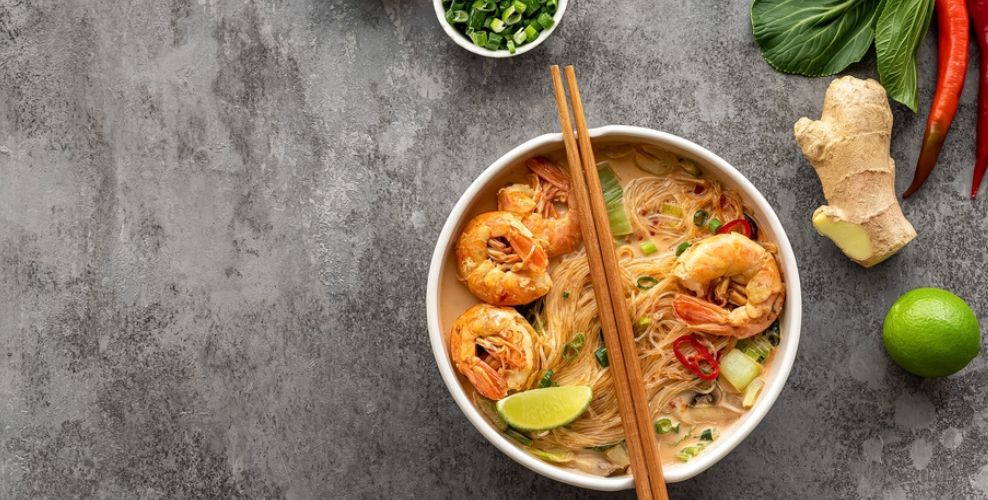Easy Prawn Laksa
While the history and origins of the laksa aren’t settled - is it Malaysian? Chinese? Indonesian? - What is settled is that laksa has been happily accepted into the fold as a super popular dish around the world. Normally considered takeaway fare, once you have a few key ingredients in your fridge, you can come back to this easy recipe time and time again.
So, if you’re craving something warming, spicy and creamy mid-week (but want to make it healthy), look no further than this super easy weeknight prawn laksa to brighten your evening.

Before we get into the recipe, let’s look at the benefits of some of these staple ingredients of Asian cooking:
How is ginger healthy?
It’s no secret that we love ginger in our cooking at Fusion - it’s a staple of both Chinese cuisine and traditional Chinese medicine. Benefits of ginger include supporting digestion, easing joint pain, boosting circulation and nausea relief.
Garlic isn’t just for flavour
Antimicrobial, antifungal - garlic is often considered a ‘natural antibiotic’.
Garlic is also beneficial for heart health due to its anti-inflammatory properties, as well as its ability to maintain healthy cholesterol.[1]
Why we love lime leaves
Lime leaves are said to reduce stress thanks to their aromatherapeutic properties. These flavoursome leaves are also anti-bacterial, preventing the growth of bacteria, including the bacteria that cause bad breath.
Surprising health benefits of coriander
Coriander has a ton of health benefits - but it’s a little known herb for detoxification. Coriander helps to remove excess toxins, including heavy metals. This popular herb is also packed full of flavonoids such as quercetin, a compound that has antioxidant and anti-inflammatory properties, and helps to relieve mild allergies - you can find out all about quercetin here.
Chili for a healthy, hot kick
A touch of chili from the red curry paste is all that’s needed to give this recipe a little kick. Chili is packed full of health benefits - it’s high in antioxidants such as vitamin C and betacarotene which help to strengthen immunity. Chili also boosts digestion and metabolism.[2]
Ingredients:
- 1 tablespoon olive oil
- 1 red onion, finely sliced
- 3cm piece fresh ginger, grated
- 2 cloves garlic, minced
- 60g thai red curry paste
- 1 can (400ml) coconut milk
- 1 cup (250ml) vegetable or fish stock
- 2 makrut (kaffir) lime leaves
- 1 bunch broccolini, chopped into thirds
- 2 - 3 large prawns, fresh or frozen
- 1 red capsicum, deseeded and thinly sliced
- 1 handful green beans, stems removed and sliced in half lengthways
- 1 teaspoon fish sauce
- Juice ½ - 1 lime
- 1 - 2 tablespoons brown, palm or coconut sugar
- 600 - 800g konjac (shirataki) noodles, rinsed well and drained
To serve:
- Fresh coriander
- Vietnamese mint
- Sliced red chilli
- Roasted peanuts
- Bean shoots
- Lime wedges
Instructions:
- Heat a large, heavy based saucepan over medium heat. Add the olive oil and onion, and fry for 2 minutes, until the onion has softened.
- Add in the ginger and garlic and fry for another 2 minutes, then add in the curry paste and fry for another minute to allow the curry paste to slightly caramelise.
- Add in the coconut milk, stock and makrut lime leaves. Bring to the boil, then reduce to a simmer for 5 minutes.
- Add in the broccolini and the prawns. Cook for 3 - 4 minutes before adding the red capsicum and green beans. Cook for another minute or two, or until the prawns are cooked through and the vegetables are tender.
- Remove from the heat and stir through the fish sauce, lime juice and sugar. Taste and adjust the seasoning if desired by adding more fish sauce for saltiness, lime juice for tang or sugar for sweetness, if required.
- Divide the well rinsed and drained konjac (shirataki) noodles between two deep bowls.
- Ladle the vegetables, prawns and laksa over the noodles and top with a handful of fresh coriander, vietnamese mint, sliced red chilli, a few roasted peanuts, bean shoots and a lime wedge.
Serves 2.
References:
- Varshney, R. et al. The Journal of Nutrition 2016;146(2):416S-421S.
- Panchal, S.K., et al. Nutrients 2018;10(5):630.
















